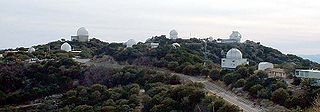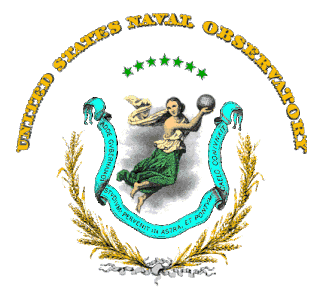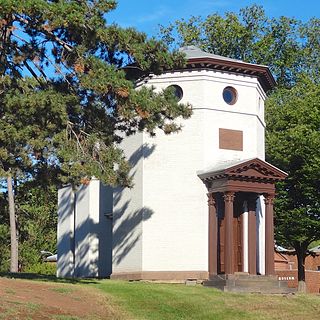
The Kitt Peak National Observatory (KPNO) is a United States astronomical observatory located on Kitt Peak of the Quinlan Mountains in the Arizona-Sonoran Desert on the Tohono O'odham Nation, 88 kilometers (55 mi) west-southwest of Tucson, Arizona. With over twenty optical and two radio telescopes, it is noted as a large and diverse gathering of astronomical instruments in the northern hemisphere.

The United States Naval Observatory (USNO) is one of the oldest scientific agencies in the United States, with a primary mission to produce Positioning, Navigation and Timing (PNT) for the United States Navy and the United States Department of Defense. Located in Northwest Washington, D.C. at the Northwestern end of Embassy Row, it is one of the pre-1900 astronomical observatories located in an urban area; at the time of its construction, it was far from the light pollution thrown off by the (then-smaller) city center. Former USNO director Gernot M. R. Winkler initiated the "Master Clock" service that the USNO still operates, and which provides precise time to the GPS satellite constellation run by the United States Air Force. The USNO performs radio VLBI-based positions of quasars with numerous global collaborators, in order to produce Earth Orientation parameters.

An observatory is a location used for observing terrestrial or celestial events. Astronomy, climatology/meteorology, geophysical, oceanography and volcanology are examples of disciplines for which observatories have been constructed. Historically, observatories were as simple as containing an astronomical sextant or Stonehenge.

The McDonald Observatory is an astronomical observatory located near the unincorporated community of Fort Davis in Jeff Davis County, Texas, United States. The facility is located on Mount Locke in the Davis Mountains of West Texas, with additional facilities on Mount Fowlkes, approximately 1.3 kilometers (0.81 mi) to the northeast. The observatory is part of the University of Texas at Austin. It is an organized research unit of the College of Natural Sciences.
The Astronomical Society of the Pacific (ASP) is an American scientific and educational organization, founded in San Francisco on February 7, 1889. Its name derives from its origins on the Pacific Coast, but today it has members all over the country and the world. It has the legal status of a nonprofit organization.

The David Dunlap Observatory (DDO) is an astronomical observatory site just north of Toronto, in Richmond Hill, Ontario, housed on a 189-acre (76 ha) estate. Formerly owned and operated by the University of Toronto, from its establishment in 1935 until 2008; the observatory is now managed by the Royal Astronomical Society of Canada, Toronto Centre (RASC-TC), and the David Dunlap Observatory Defenders (DDOD). Its primary instrument is a 74-inch (1.88 m) reflector telescope, at one time the second-largest telescope in the world, and still the largest in Canada. Several other telescopes are also located at the site, which formerly also included a small radio telescope. The legacy of the David Dunlap Observatory continues in the Dunlap Institute for Astronomy & Astrophysics, a research institute at the University of Toronto established in 2008.

Roque de los Muchachos Observatory is an astronomical observatory located in the municipality of Garafía on the island of La Palma in the Canary Islands. The observatory site is operated by the Instituto de Astrofísica de Canarias, based on nearby Tenerife. ORM is part of the European Northern Observatory.

The Dominion Observatory was an astronomical observatory in Ottawa, Ontario that operated from 1902 to 1970. The Observatory was also an institution within the Canadian Federal Government. The observatory grew out of the Department of the Interior's need for the precise coordinates and timekeeping that at that time could only come from an observatory. For several years they had used a small observatory on the Ottawa River for this purpose. In 1902, it was decided that Canada needed a larger national observatory similar to the Royal Greenwich Observatory in Britain.

South African Astronomical Observatory (SAAO) is the national centre for optical and infrared astronomy in South Africa. It was established in 1972. The observatory is run by the National Research Foundation of South Africa. The facility's function is to conduct research in astronomy and astrophysics. The primary telescopes are located in Sutherland, which is 370 kilometres (230 mi) from Observatory, Cape Town, where the headquarters is located.
Andrew David Thackeray, was an astronomer trained at Cambridge University. He served as director of the Radcliffe Observatory for 23 years.

Allan I. Carswell Astronomical Observatory formerly known as the York University Astronomical Observatory is an astronomical observatory owned and operated by York University. It is located in the North York district of Toronto, Ontario, Canada. Opened in 1969, York's observatory is opened to both researchers and amateur astronomers. The observatory was renamed Allan Ian Carswell Astronomical Observatory in 2017 after York University Emeritus Professor of Physics Allan Carswell.

Islamic astronomy comprises the astronomical developments made in the Islamic world, particularly during the Islamic Golden Age, and mostly written in the Arabic language. These developments mostly took place in the Middle East, Central Asia, Al-Andalus, and North Africa, and later in the Far East and India. It closely parallels the genesis of other Islamic sciences in its assimilation of foreign material and the amalgamation of the disparate elements of that material to create a science with Islamic characteristics. These included Greek, Sassanid, and Indian works in particular, which were translated and built upon.
Bradstreet is a surname. Notable people with the surname include:

The Hirsch Observatory is an astronomical observatory at Rensselaer Polytechnic Institute (RPI) in Troy, New York. It is located on the roof of the Jonsson-Rowland Science Center and is used by members of the Rensselaer Astrophysical Society as well as astronomy students in laboratory exercises. It is frequently opened to the community for public viewing sessions. The observatory's main dome contains a 16" Cassegrain Reflector, with a CCD camera and fully computerized controls. The observatory also owns a variety of smaller scopes and a SBIG Spectrograph. The spectrograph has been used to catalog bright solar spectrum as part of an effort to create an online digital database for astrophysical research. The current director of the observatory is Professor Heidi Newberg.

Heidelberg-Königstuhl State Observatory is a historic astronomical observatory located near the summit of the Königstuhl hill in the city of Heidelberg in Germany. The predecessor of the current observatory was originally opened in 1774 in the nearby city of Mannheim but degradation of observational conditions there resulted in a relocation to the Königstuhl in 1898.

The Meade LX200 is a family of commercial telescopes produced by Meade Instruments launched in 1992 with 8" (20.32 cm) and a 10" (25.4 cm) Schmidt–Cassegrain models on computerized altazimuth mounts. Two larger models, a 12" (30.48 cm) and a 16" (40.64 cm), quickly followed. The original version was later informally named the "classic" LX200 as newer upgraded versions replaced it. The first of these was the LX200GPS, which featured global positioning system electronics. A 360 mm (14 in) LX200GPS was later added to the line.

The Great Comet of 1901, sometimes known as Comet Viscara, formally designated C/1901 G1, was a comet which became bright in the spring of 1901. Visible exclusively from the southern hemisphere, it was discovered on the morning of April 12, 1901 as a naked-eye object of second magnitude with a short tail. On the day of perihelion passage, the comet's head was reported as deep yellowish in color, trailing a 10-degree tail. It was last seen by the naked eye on May 23.

The Royal Observatory, Cape of Good Hope, is the oldest continuously existing scientific institution in South Africa. Founded by the British Board of Longitude in 1820, it now forms the headquarters building of the South African Astronomical Observatory.

The Daniel S. Schanck Observatory is an historical astronomical observatory on the Queens Campus of Rutgers University in New Brunswick, New Jersey, United States, and is tied for the seventh oldest observatory in the US alongside the Vassar College Observatory. It is located on George Street near the corner with Hamilton Street, opposite the parking lot adjacent to Kirkpatrick Chapel, and to the northeast of Old Queens and Geology Hall.
















